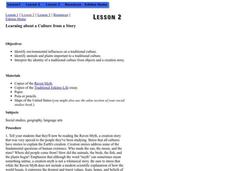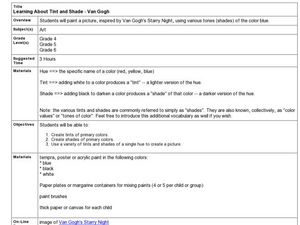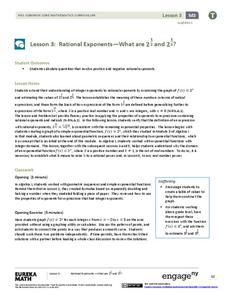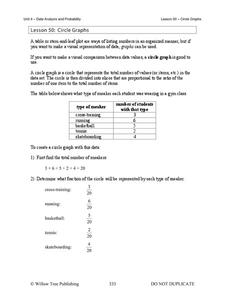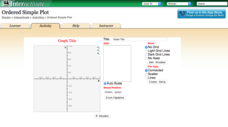Curated OER
Reading Basic Music Notes
First graders develop skills in reading music notes. In this reading music lesson plan, 1st graders clap and chant rhythm patterns and learn music vocabulary. Students also match patterns by listening to the teacher perform the pattern.
Curated OER
Let's Go Value Shopping
Students count, figure change, and find the value of saving in a classroom store.
Curated OER
Native Cultures and Values
Students learn about Native American culture. In this history and diversity lesson, students use a website to create a timeline of significant events, contributions, growth and developments of Native American culture...
Curated OER
Learning about a Culture from a Story
Students interpret the identity of a traditional culture from objects and a creation story. In this lesson on learning about a culture from a story, students read and analyze an Eskimo myth about creation and an essay on Traditional...
National Energy Education Development Project
Introduction to Wind Energy
The U.S. produced enough wind energy in 2015 to power all of the homes in Alaska, California, Delaware, the District of Columbia, Hawaii, Idaho, Maine, Montana, Nebraska, New Hampshire, North Dakota, Rhode Island, South Dakota, and...
Flipped Math
Calculus AB/BC - Estimating Derivatives of a Function at a Point
It seems like it should be about three. Pupils learn to get an estimate of the derivative of a function at a point by using the derivative functionality of their graphing calculators. They take that information to determine the equation...
Curated OER
How Do Values Shape Conflicts?
Students work through conflict. In this conflict resolution lesson, students participate in a simulation that requires them to consider both sides of the whaling issue.
Curated OER
Power and the Communication of Values in West African Art of the Past and Present
Ninth graders examine art from West Africa from the past and present. In groups, they compare their community to the one depicted in the artwork and note the similiarities. To end the lesson, they discuss the concept of power and how...
Curated OER
Place Value: Hundreds, Tens, Ones
In this place value worksheet, students look at a number in a left column, then in the right column, write how many hundreds, tens and ones are in that number.
Curated OER
Learning about Tint and Shade- Van Gogh
Learners explore tint, hues, and shades of color. In this art and color instructional activity, students observe and discuss Van Gogh's artistic style. Learners mix paints to create a single hue background and add details to paint a...
EngageNY
Researching about the Red Cross, Continued: Who Is the Red Cross and What Does This Multinational Organization Do?
Code red! Learners read an informational article about the Red Cross, discussing the gist of the text in small groups. On a three-column note catcher, pupils take notes to show how the Red Cross functions as a multinational aid...
Center for Civic Education
The Power of Nonviolence: The Children's March
What was the Children's Crusade and how did it impact the civil rights movement in the United States? Your young learners will learn about this incredible event through a variety of instructional activities, from reading a poem and...
EngageNY
Rational Exponents—What are 2^1/2 and 2^1/3?
Are you rooting for your high schoolers to learn about rational exponents? In the third installment of a 35-part module, pupils first learn the meaning of 2^(1/n) by estimating values on the graph of y = 2^x and by using algebraic...
Teach Engineering
Spring Away!
The last segment of the nine-part unit makes a connection between springs and linear equations. Groups hang weights from the spring and measure its length. Then, using the data collected, they calculate the slope to find the k-value...
EngageNY
From Ratio Tables, Equations and Double Number Line Diagrams to Plots on the Coordinate Plane
Represent ratios using a variety of methods. Classmates combine the representations of ratios previously learned with the coordinate plane. Using ratio tables, equations, double number lines, and ordered pairs to represent...
Bob Prior
The Order of Operations
Your learners use many different number representations like positive and negative integers, exponents, radicals, and combinations of operations as they learn and strengthen their use of the order of operations. Thoughtfully organized to...
EngageNY
Sine and Cosine of Complementary Angles and Special Angles
Building trigonometric basics here will last a mathematical lifetime. Learners expand on the previous lesson in a 36-part series by examining relationships between the sine and cosine of complementary angles. They also review the...
Willow Tree
Circle Graphs
Pie isn't just for eating! Scholars learn to create pie charts and circle graphs to represent data. Given raw data, learners determine the percent of the whole for each category and then figure out the degree of the circle that percent...
EngageNY
Logarithms—How Many Digits Do You Need?
Forget your ID number? Your pupils learn to use logarithms to determine the number of digits or characters necessary to create individual ID numbers for all members of a group.
Curated OER
Graphite Embossing
Teach your art class a lesson on viewing positive and negative space in multiple dimensions. They will use metal sheets and various pencil grades to apply the graphite embossing technique. This project will result in two contrasting images.
Shodor Education Foundation
Ordered Simple Plot
Open your imagination to make algebra-inspired creations. An interactive lesson has scholars graph images from a set of parameters. Users can practice minimum values, maximum values, and scale as well as key features.
Curated OER
Studying Contraception
Abstinence, different contraceptives, decision-making about sexual activity, and peer pressure are a few of the topics in this lesson. Did you know the majority of youth are not sexually active? This would be a great jumping off point...
EngageNY
A Focus on Square Roots
Pupils learn to solve square root equations and rationalize denominators. Problems include those with extraneous solutions.
EngageNY
Percent Rate of Change
If mathematicians know the secret to compound interest, why aren't more of them rich? Young mathematicians explore compound interest with exponential functions in the twenty-seventh installment of a 35-part module. They calculate future...



